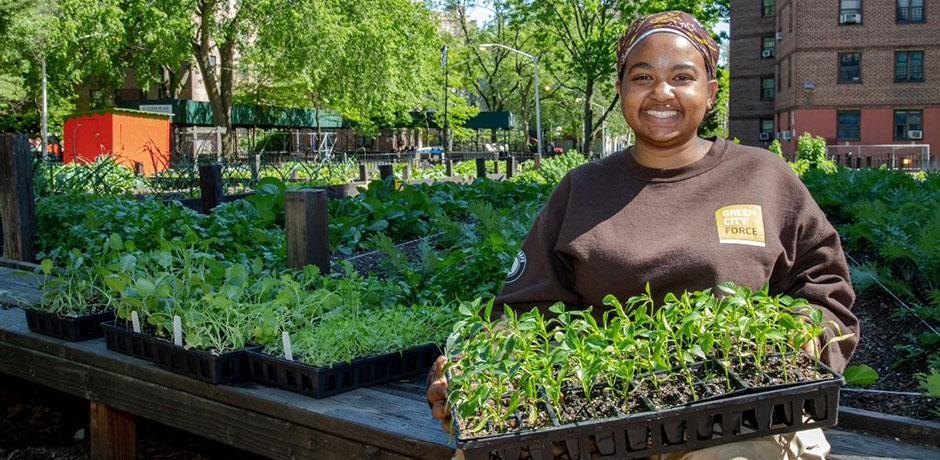City Blooming Fundamentals Explained
City Blooming Fundamentals Explained
Blog Article
City Blooming Fundamentals Explained
Table of ContentsCity Blooming Things To Know Before You BuyUnknown Facts About City BloomingAbout City BloomingThe 9-Minute Rule for City BloomingIndicators on City Blooming You Need To Know
Interested in growing food to buy in the City of Chicago? Considering starting a community yard? Changes to the Chicago Zoning Regulation allow agricultural uses like neighborhood yards and metropolitan farms in numerous components of the city. Below is a listing of regularly asked inquiries regarding the guidelines and guidelines that growers must take into consideration when intending a metropolitan farming task.
The zoning amendment does not customize any other codes handling composting, building permits, acquiring or leasing City possessed residential property, service licenses or environmental contamination. There are existing codes that control these problems and they remain completely effect and may be appropriate to your task. Community gardens are generally had or taken care of by public entities, civic organizations or community-based organizations and kept by volunteers.
Urban ranches expand food that is planned to be sold, either on a nonprofit or for-profit basis. Due to their industrial function, urban ranches require an organization certificate. Yes. An area yard is enabled to sell surplus generate that was grown on website if the sales are accessory or subordinate to the yard's primary purpose described above.
Everything about City Blooming
Composting is permitted however only for plant material that is produced and used on site. The quantity of garden compost material can not surpass 25 cubic backyards at any type of provided time according to the requirements in 7-28-715 of the City's Municipal Code. Yes. Since the soil at most new yard sites needs changing, compost, dirt, timber chips, or various other products can be obtained to construct or enhance the expanding area - container and raised bed gardening etc..

If a building permit is needed then the hoophouse will be thought about an accessory structure. You can discover even more concerning the structure authorization requirements by getting in touch with the Department of Structures. The 25,000-square-foot dimension restriction is planned to stop a solitary area yard from controling a provided block or detracting from the block's existing residential or business character.
The limitation does not put on yards found in Public Open Space (POS) districts. Can there be greater than one community garden that is 25,000 square feet on a single block? Yes. The size limit relates to specific yards, not to individual blocks. No. Secure fencing is not needed, nonetheless, gardens that have big parking lot might be called for to set up fencing or other landscape design functions.
Examine This Report on City Blooming
B1 & B2 districts need that all industrial usage activities be conducted inside. Is helpful hints secure fencing required for urban ranches? Fencings may be needed, along with landscape design and testing, for specific parking areas and exterior job or storage locations depending on place and the specific activity taking place.
Urban ranches need building permits and zoning approvals prior to building and construction (balcony and patio garden design). Various other forms of city testimonial might be needed depending on particular structures, activities, dimension, landscape design, licensing, public health and stormwater monitoring issues.
The Division of Business Affairs and Customer Defense can assist figure out the details kind of service certificate that's needed. Off road parking is required for the majority of industrial tasks in Chicago. The required number of car parking spaces is based on the number of workers working on website and not the square video of the expanding room.
10 Easy Facts About City Blooming Explained

Yes. An urban farm can offer compost material produced on website, nonetheless, the operation should adhere to the policies in 7-28-715 of the Chicago Municipal Code. Yes. Aquaponic systems are enabled inside your home on metropolitan ranches in many zoning districts. Nevertheless, a zoning testimonial and structure permit is needed in order to set up frameworks or systems and an organization license is called for as defined over.
As much as 5 hives or colonies of honey may be kept as an accessory usage. Nonetheless, beekeepers should sign up with the Illinois Department of Farming. For more info about the suggested zoning modification you might get in touch with the Division of Housing and Economic Development, Bureau of Preparation and Zoning at 312.744.8563.
Farming in cities and city areas A metropolitan farm in Chicago. Urban farming describes numerous techniques of growing. https://www.merchantcircle.com/blogs/city-blooming-san-francisco-ca/2024/6/City-Gardening-Growing-Urban-Spaces/2755418, processing, and dispersing food in metropolitan locations. The term also puts on the area tasks of animal husbandry, aquaculture, beekeeping, and gardening in an urban context. Urban agriculture is identified from peri-urban farming, which occurs in country areas at the edge of suburbs.
Some Known Details About City Blooming
, who seek to form social networks founded on a common values of nature and area holism. These networks can create by means of official institutional support, coming to be integrated right into local community planning as a "shift town" motion for sustainable city growth.
Some of the first proof of city farming comes from Mesopotamia.
Report this page